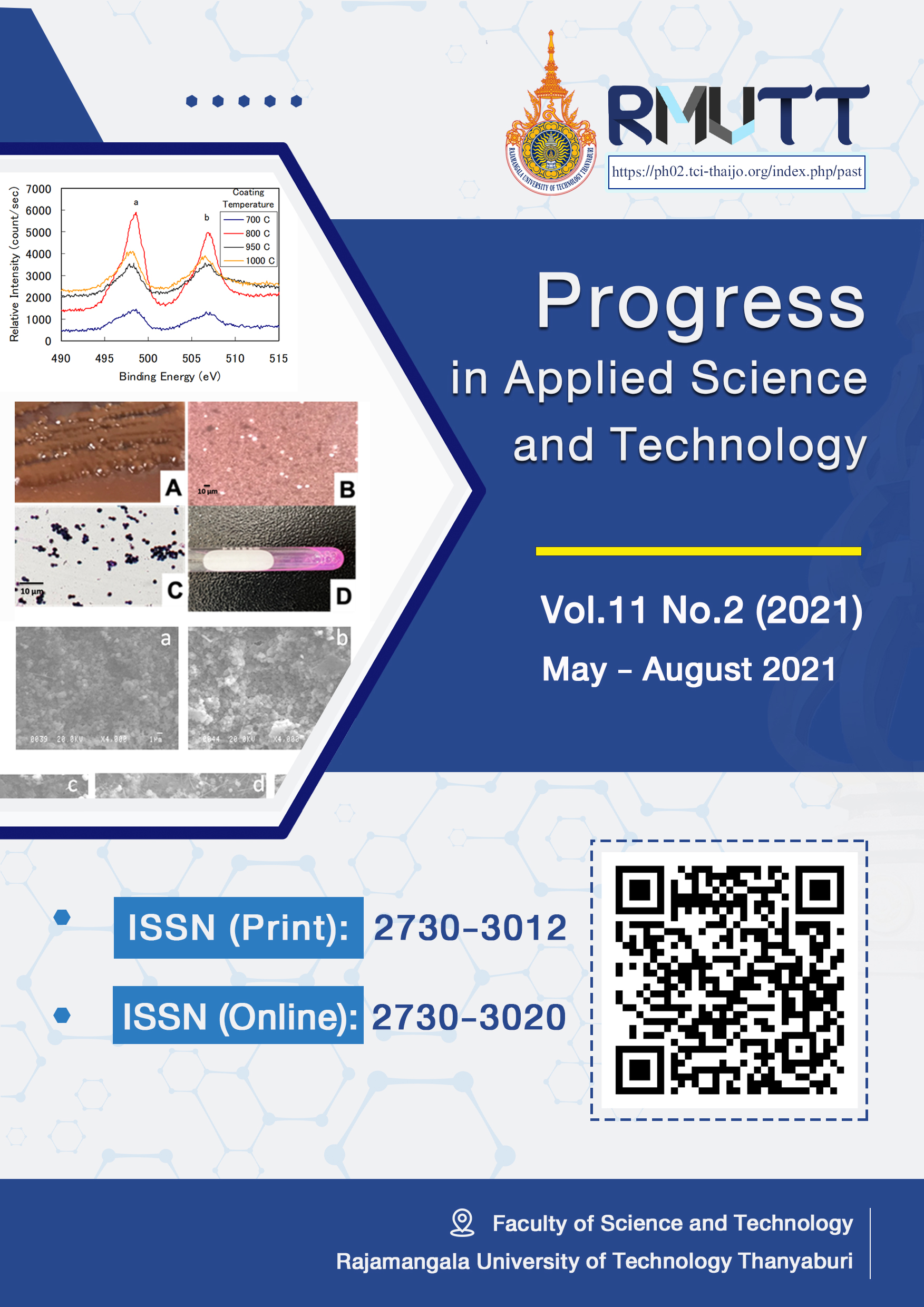Effect of Filler Starches on Mechanical, Thermal and Degradation Properties of Low-Density Polyethylene Composites
Main Article Content
Abstract
In this study, five types of starches (sago, corn, tapioca, potato, and wheat starches) were blended with low-density polyethylene (LDPE) via melt blending technique followed by injection molding to manufacture LDPE/starch composites. Each starch content varied from 5-30 wt% of LDPE. Starch inclusion in LDPE reduced tensile strength, elongation at break, and impact strength, while tensile modulus increased significantly with increasing starch content. To provide fine starch dispersion, glycerol (30 wt% based on the starch content) was used as a plasticizer and compatibilizer. The effect of thermoplastic starch content on the properties of LDPE composites was investigated. The presence of a plasticizer or compatibilizer in the LDPE/starch composite produced better properties for sago starch-filled composite than other starches-filled composites, indicating better dispersion and homogeneity of starch in the matrix. Morphological studies of fractured surfaces using scanning electron microscopy (SEM) have revealed that the miscibility of such a blend depends on the type of starch used. The thermal testing results show that the addition of thermoplastic starch in the LDPE can increase the degradation temperature as well as the decomposition temperature and melting temperature of these composites did not change but the degree of crystallinity of the LDPE phase was slightly decreased. The water uptake of composite increased with soaking time and the application of thermoplastic sago starch samples was found to be the lowest water absorption compared to other starches. However, outdoor weather tests can show that the biodegradability of thermoplastic starch composites has increased with increasing degradation time.
Article Details

This work is licensed under a Creative Commons Attribution-NonCommercial-NoDerivatives 4.0 International License.
References
Sun X., Yang F., and Yao Z. Influence of Ungrafted Monomers in Graft Copolymers on Electrical Insulating Properties of Polyethylene. Ind Eng Chem Res. 2020; 59: 16112-21.
Shah A.A., Hasan F., Hameed A. and Ahmed S. Biological degradation of plastics: a comprehensive review. Biotechnol Adv. 2008; 26: 246-65.
Zaman H.U., Khan A., Hossain M., Khan M.A. and Khan R.A. Physico-mechanical, interfacial, degradation, and dielectric properties of jute/PP composites: Effect of dye and Gamma radiation. Int J Polym Mater. 2012; 61: 596-610.
Gray N., Hamzeh Y., Kaboorani A. and Abdulkhani A. Influence of cellulose nanocrystal on strength and properties of low-density polyethylene and thermoplastic starch composites. Ind Crop Prod. 2018; 115: 298-305.
Tester R.F., Karkalas J. and Qi X. Starch-composition, fine structure, and architecture. J cereal Sci. 2004; 39: 151-65.
Datta D. and Halder G. Effect of rice husk derived nanosilica on the structure, properties, and biodegradability of corn-starch/LDPE composites. J Polym Environ. 2019; 27: 710-27.
Zaman H.U. and Beg M. Effect of CaCO3 contents on the properties of polyethylene nanocomposites sheets. Fiber Polym. 2014; 15: 839-46.
Datta D. and Halder G. Enhancing degradability of plastic waste by dispersing starch into low-density polyethylene matrix. Process Saf Environ. 2018; 114: 143-52.
Peres A.M., Pires R.R. and Oréfice R.L. Evaluation of the effect of reprocessing on the structure and properties of low-density polyethylene/thermoplastic starch blends. Carbohyd Polym. 2016; 136: 210-15.
Durmuş A., Woo M., Kaşgöz A., Macosko C.W. and Tsapatsis M. Intercalated linear low-density polyethylene (LLDPE)/clay nanocomposites prepared with oxidized polyethylene as a new type compatibilizer: structural, mechanical and barrier properties. Eur Polym J. 2007; 43: 3737-49.
Beg M., Kormin S., Bijarimi M., and Zaman H.U. Preparation and characterization of low‐density Polyethylene/Thermoplastic starch composites. Adv Polym Tech. 2016; 35: 1-9.
Yamak H.B. Thermal, mechanical, and water resistance properties of LDPE/starch bio-based polymer blends for food packing applications. J Turk Chem Soc Sect A: Chem. 2016; 3: 637-56.
Beg M.D.H., Kormin S.B., Bijarimi M. and Zaman H.U. Effects of different starch types on the physicomechanical and morphological properties of low-density polyethylene composites. J Polym Eng. 2015; 35: 793-804.
Mali S., Karam L.B., Ramos L.P., and Grossmann M.V.E. Relationships among the composition and physicochemical properties of starches with the characteristics of their films. J Agr Food Chem. 2004; 52: 7720-25.
Majid R.A., Ismail H. and Taib R.M. The effects of natural weathering on the properties of linear density polyethylene (LDPE)/thermoplastic sago starch (TPSS) blends. Polym-Plast Technol. 2010; 49: 1142-49.
Shogren R., Thompson A., Felker F., Harry‐Okuru R., Gordon S., Greene R., et al. Polymer compatibility and biodegradation of starch–poly (ethylene‐co‐acrylic acid)–polyethylene blends. J Appl Polym Sci. 1992; 44: 1971-78.
Karimi M. and Biria D. The promiscuous activity of alpha-amylase in biodegradation of low-density polyethylene in a polymer-starch blend. Sci Rep-UK. 2019; 9: 1-10.
Khan M.A., Khan R.A., Haydaruzzaman, Ghoshal S., Siddiky M. and Saha M. Study on the physicomechanical properties of starch-treated jute yarn-reinforced polypropylene composites: effect of gamma radiation. Polym-Plast Technol. 2009; 48: 542-48.
Ardhyananta H., Ismail H. and Takeichi T. Effects of organoclay loading and ethylene glycol on mechanical, morphology and thermal properties of ethylene-vinyl acetate/organoclay nanocomposites. J Reinf Plast Comp. 2007; 26: 789-806.
Zaman H.U., Khan M.A. and Khan R.A. Physico-mechanical and degradation properties of banana fiber/LDPE composites: effect of acrylic monomer and starch. Compos Interface. 2011; 18: 685-700.
Zaman H.U., Khan M.A., Khan R.A., Mollah M., Pervin S., and Al-Mamun M. A comparative study between gamma and UV radiation of jute fabrics/polypropylene composites: effect of starch. J Reinf Plast Comp. 2010; 29: 1930-39.
Averous L., Moro L., Dole P. and Fringant C. Properties of thermoplastic blends: starch–polycaprolactone. Polymer. 2000; 41: 4157-67.
Zaman H.U., Khan M.A., Khan R.A. and Beg D. A comparative study on the mechanical, degradation, and interfacial properties of jute/LLDPE and jute/natural rubber composites. Int J Polym Mater. 2011; 60: 303-15.
Khan R.A., Haque M., Huq T., Khan M.A., Zaman H.U., Fatema K.J., et al. Studies on the relative degradation and interfacial properties between jute/polypropylene and jute/natural rubber composites. J Thermoplast Compos. 2010; 23: 665-81.
Mani R. and Bhattacharya M. Properties of injection-molded starch/synthetic polymer blends—III. Effect of amylopectin to amylose ratio in starch. Eur Polym J. 1998; 34: 1467-75.






